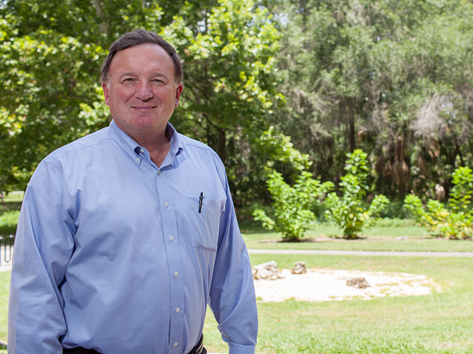 By many measures the double lung transplant was a success. The young man with cystic fibrosis had received healthy organs and the results of his pulmonary function tests were very good, nearly normal in fact. Yet he was still unable to breathe on his own, making him dependent on a ventilator, just as he had been before the transplant.
By many measures the double lung transplant was a success. The young man with cystic fibrosis had received healthy organs and the results of his pulmonary function tests were very good, nearly normal in fact. Yet he was still unable to breathe on his own, making him dependent on a ventilator, just as he had been before the transplant.
“It became apparent he was having trouble breathing because his breathing muscles had become de-conditioned and weak,” said A. Daniel Martin, Ph.D., P.T., a professor in the department of physical therapy, who worked with the patient.
The experience of the young man and other patients like him sparked Martin’s interest in developing techniques to help move patients from mechanical ventilation to independent breathing. The treatments Martin and his colleagues have developed are designed to combat diaphragm atrophy.
“The diaphragm is a skeletal muscle, just like a leg or arm muscle and if you don’t use it, it gets weak,” Martin said. “The diaphragm is very unique because it’s so chronically active. When it suddenly becomes inactive, as happens when someone is given ventilator support, it gets weak 8 to 10 times faster than a limb muscle.”
Martin collaborates with Jeff Brown, RRT, and other respiratory therapists, surgeons and nurses from intensive care units at Shands at UF’s South Tower. Martin works with two patient groups: patients before and after lung transplant, and patients who are unable to recover breathing ability after receiving long-term mechanical ventilation, a condition known as failure to wean.
In patients with failure to wean, Martin uses inspiratory muscle strength training, or IMST, to help patients regain strength in the muscles used in inspiration. In a recent study led by Martin, researchers tested the IMST therapy in 69 participants hospitalized in intensive care units — 35 were randomly assigned to IMST and 34 to a sham treatment. By the end of the study, 71 percent of the participants who received IMST therapy were able to wean from mechanical ventilation, compared to 47 percent of patients in the sham group, a rate comparable to usual care. The study is the first published controlled trial of a rehabilitation program for patients with failure to wean.
IMST is based on the same concept of other strength training programs in that increasing loads, or pressure, progressively strengthen muscles. In IMST the pressure is delivered through a small, calibrated device attached to a participant’s tracheostomy tube. Patients are told to inhale and exhale as forcefully as possible during the training breaths and the pressure is increased daily.
“It’s just like having a set of dumbbells,” Martin said. “If you took somebody to the gym and wanted to get their biceps stronger you’d have them start out at a moderate load with the dumbbell and then as they get stronger you increase the load. It’s the same thing with this device, but rather than using weight, we use pressure as the loading mode and as patients get stronger we make the muscle work harder and harder.”
Transitioning from mechanical ventilation to independent breathing is important for patients’ health and well-being and containing health care costs, Martin said.
“There are a lot of problems with being on a ventilator,” he said. “Mechanical ventilation has a significant incidence of complications, including respiratory infections and damage to the vocal folds and lungs, it’s uncomfortable for patients and the cost of sustaining a patient on mechanical ventilation is substantial.”
Martin and Lawrence Caruso, M.D., and Andrea Gabrielli, M.D., anesthesiologists in the UF College of Medicine’s division of critical care medicine, are currently conducting a study funded by the Florida Department of Health on the effect of providing IMST training to patients who have been ventilated for as little as three days.
“Rather than waiting until patients are chronically dependent upon the ventilator we’re trying to start the therapy much sooner,” Martin said.

